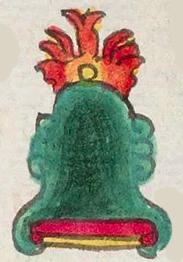Tlachinolticpac (Mdz15v)
This compound glyph stands for the place name Tlachinolticpac. It shows a fire or conflagration (tlachinolli) on top (-ticpac) of a hill or mountain (tepetl), but the hill does not have a phonetic value in the place name]. The shape of the fire almost recalls a bird or butterfly with wings raised. The flames are red-orange, and the center is yellow. A small circle resides at the very heart of the fire, almost like a setting sun in a fiery sky. The locative suffix (-ticpac) is visual in its placement.
Stephanie Wood
The fire-bird or butterfly likeness might not be coincidental. In our Online Nahuatl Dictionary we see an attestation to the word tlachinolli being likened to a cardinal or scarlet macaw (cuezalin, and cuezalin feathers appear much like flames in various glyphs in the Codex Mendoza. Furthermore, the wings of a butterfly can flicker like flames of a fire, and so butterflies have an association with fire. [See: Markman and Markman, Masks of the Spirit, 1989, 148.] See also the glyphs, below, for the name Tlepapalotl (flame-butterfly).
Tlachinolli is part of the diphrase or diphrasism, in atl, in tlachinolli (disaster), that literally refers to water and scorched earth. Katarzyna Mikulska (2020, 52-54) discusses the possibility for diphrasisms and metonymic series (after Dehouve) to be "represented graphically." She gives various examples of the atl-tlachinolli diphrase. See also Mercedes Montes de Oca Vega's discussion of couplets in Nahuatl (with iconographic expressions) in Mexicolore.
Stephanie Wood
tlachinolticpac
Tlachinolticpac
Stephanie Wood
c. 1541, or by 1553 at the latest
Stephanie Wood
fires, war, conflagration, something burned, feathers, plumas, birds, nombres de lugares

tlachinol(li), conflagration, https://nahuatl.wired-humanities.org/content/tlachinolli
-ti- (ligature), https://nahuatl.wired-humanities.org/content/ti
-icpac (locative suffix, above or on top), https://nahuatl.wired-humanities.org/content/icpac
James Lockhart (The Nahuas, 1992, 120) refers to the name Yaotlachinol, witnessed in a census from the Cuernavaca region (1535–45), calling it as "The Scorching of War."
Codex Mendoza, folio 15 verso, https://digital.bodleian.ox.ac.uk/objects/2fea788e-2aa2-4f08-b6d9-648c00..., image 41 of 188.
The Bodleian Libraries, University of Oxford, hold the original manuscript, the MS. Arch. Selden. A. 1. This image is published here under the UK Creative Commons, “Attribution-NonCommercial-ShareAlike 3.0 License” (CC-BY-NC-SA 3.0).







